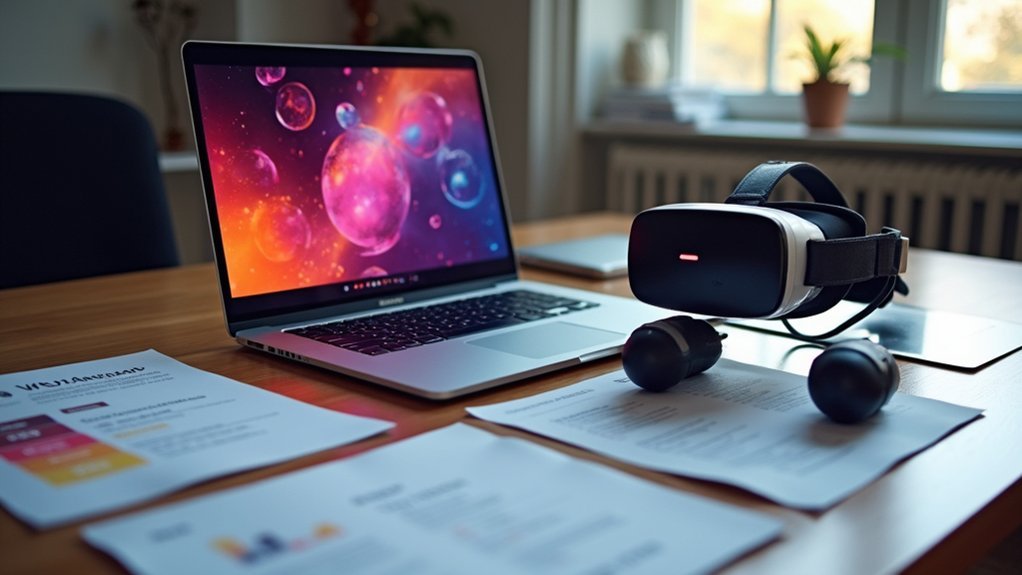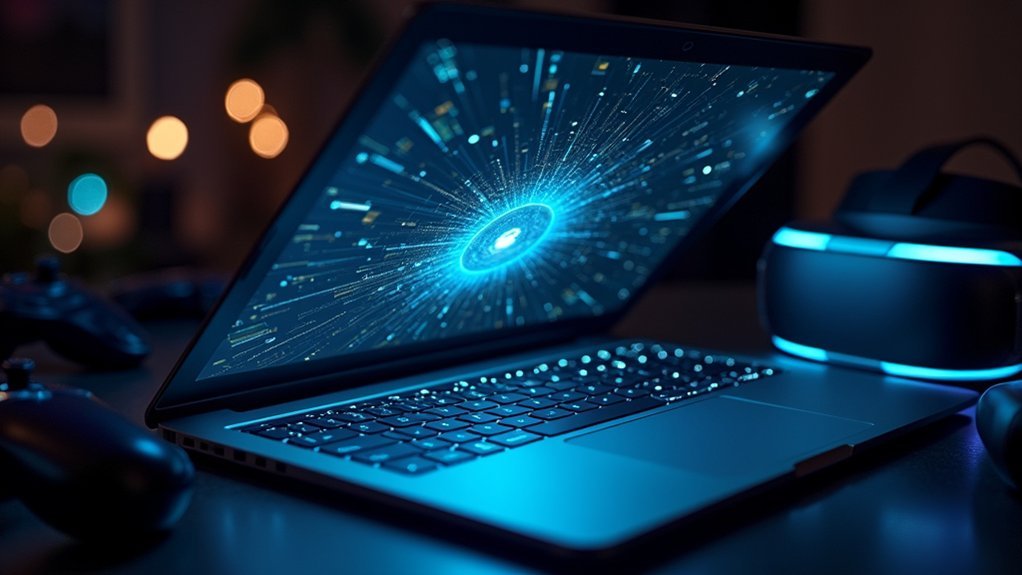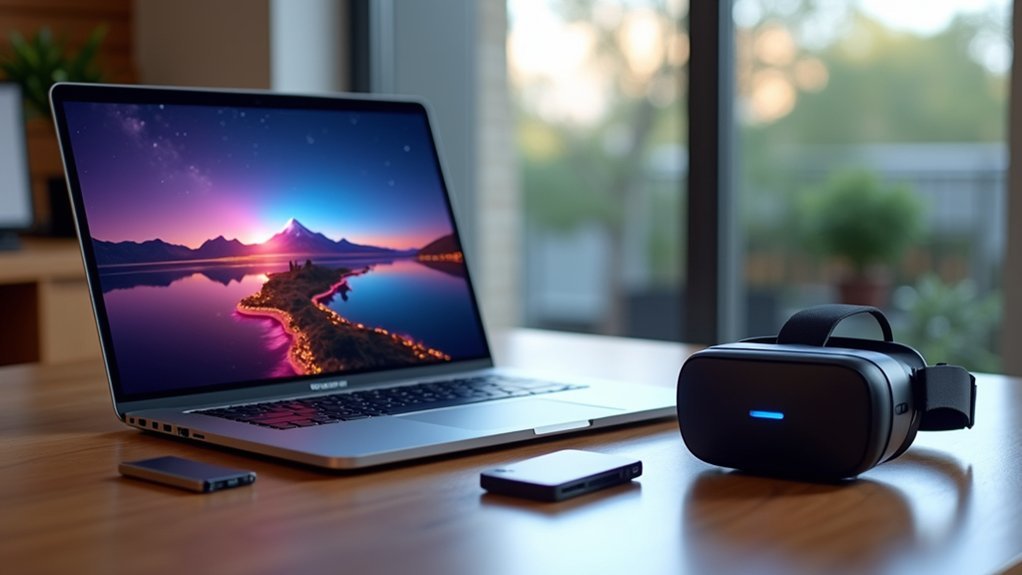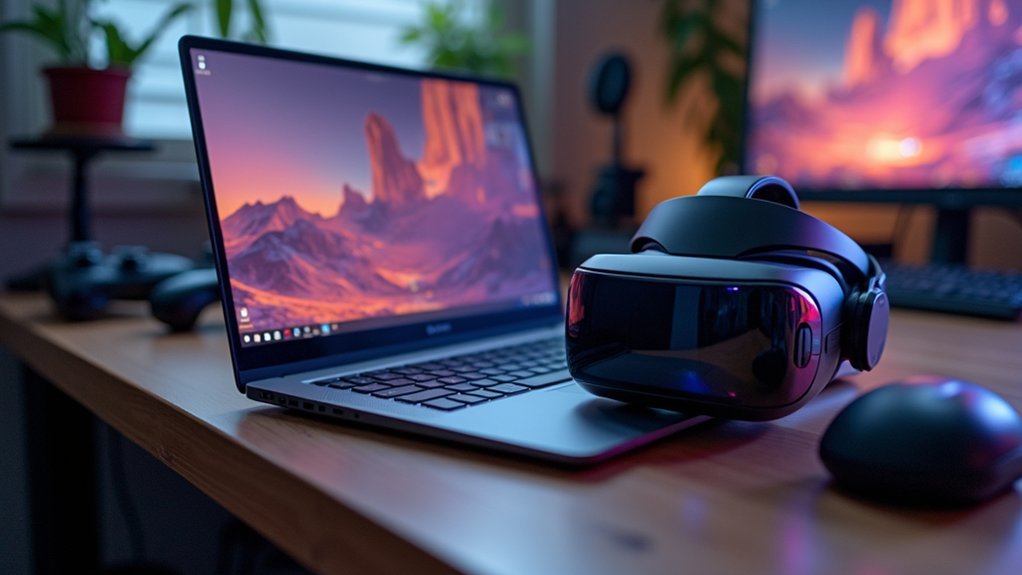When choosing a VR-powered laptop, you’ll need a dedicated GPU like the NVIDIA RTX 40 series or AMD RX 7000 series, at least 16GB of RAM (32GB recommended), and a multi-core processor such as Intel i7-12650H or AMD Ryzen 7 5800H. Prioritize 1TB SSD storage for faster load times and guarantee robust cooling systems to prevent throttling during intensive VR sessions. Consider connectivity options including USB 3.0 ports and DisplayPort compatibility for seamless headset integration, and the following guide explores these specifications in greater detail.
Understanding VR System Requirements and Specifications

When you’re shopping for a VR-capable laptop, understanding the core hardware requirements isn’t just helpful—it’s vital for avoiding costly mistakes.
Your graphics processing unit (GPU) forms the foundation of VR performance, with NVIDIA GTX 1060 or AMD Radeon RX480 representing the minimum threshold for smooth experiences.
Your GPU serves as VR’s backbone—NVIDIA GTX 1060 or AMD RX480 mark the bare minimum for acceptable performance.
You’ll need at least 16GB of RAM for basic VR applications, though 32GB delivers superior performance for demanding scenarios.
Your CPU should match an Intel i7-12650H or AMD Ryzen 7 5800H to handle computational loads effectively.
For storage, prioritize a 1TB SSD over traditional drives—the faster load times dramatically improve your VR experience.
Don’t overlook connectivity; verify your laptop includes USB 3.0 ports and DisplayPort compatibility for seamless headset integration.
Graphics Card Performance: The Heart of VR Gaming
Your graphics card determines whether you’ll experience seamless virtual worlds or frustrating stutters that break immersion entirely.
The graphics processing unit (GPU) serves as VR’s powerhouse, rendering complex environments fast enough to prevent motion sickness. Gaming laptops need dedicated GPUs like NVIDIA GeForce RTX 40 series or AMD’s RX 7000 series for superior VR performance.
Consider these essential GPU specifications:
- Video RAM (VRAM): Higher amounts handle high-resolution textures better, enhancing visual fidelity
- Total Graphics Power (TGP): Target above 105W for demanding VR applications
- Frame Rate Capability: Aim for GPUs maintaining at least 60 frames per second consistently
Your GPU’s video RAM capacity directly impacts texture quality and overall visual experience.
Don’t compromise here—VR demands processing power that entry-level graphics simply can’t deliver for truly immersive gaming.
Processor Power: CPU Requirements for Smooth VR Performance

While your graphics card handles the visual heavy lifting, your processor orchestrates the complex behind-the-scenes calculations that keep VR experiences running smoothly.
For peak processor power, you’ll want multi-core CPUs like the Intel Core i7-12650H or AMD Ryzen 7 5800H, which deliver the computational strength needed for tracking and physics calculations. These CPU requirements guarantee smooth VR performance without frustrating delays during virtual interactions.
Multi-core processors like Intel i7-12650H and AMD Ryzen 7 5800H provide the computational power essential for seamless VR tracking and physics.
You’ll need at least 16GB RAM alongside your processor since VR applications demand significant memory capacity for multitasking. Higher clock speeds improve responsiveness, making every virtual interaction feel natural.
For top-tier performance, consider Intel Core i9 or AMD Ryzen 9 series processors, which excel in gaming and VR benchmarks. Verify your chosen CPU supports the latest VR standards for future compatibility.
Memory and RAM: Ensuring Adequate System Resources
You’ll need at least 16GB of RAM to run VR applications smoothly, though 32GB or more delivers considerably better performance for demanding software.
Your laptop’s memory directly affects how well it handles complex VR environments and high-resolution textures, making adequate RAM essential for seamless experiences.
Since upgrading laptop RAM can be limited, choosing sufficient memory upfront protects against future VR requirements.
RAM Requirements for VR
Sixteen gigabytes of RAM represents the minimum threshold for smooth VR performance, but don’t settle for the bare minimum when investing in a VR-capable laptop.
You’ll want 32GB to handle demanding VR applications while maintaining excellent multitasking capabilities. Insufficient RAM creates performance bottlenecks that’ll ruin your immersive experience with frustrating lag and slowdowns.
VR-ready laptops with adequate memory paired with SSDs deliver notably faster loading times and smoother gameplay.
You’re making a long-term investment, so prioritize models offering upgradeable RAM options to future-proof your system as VR software demands evolve.
- 32GB RAM enables seamless multitasking between multiple VR applications without performance degradation
- SSD and RAM combinations dramatically reduce loading times and enhance overall system fluidity
- Upgradeable memory slots provide flexibility for future expansion as VR requirements increase
Memory Performance Impact
Memory performance directly determines whether your VR experience feels seamless or suffers from jarring interruptions. When your laptop lacks sufficient RAM, you’ll encounter frustrating bottlenecks that manifest as stuttering, delays, and choppy gameplay during VR sessions.
Resource-intensive VR applications demand quick data access for real-time rendering and movement tracking, making 16GB RAM the recommended minimum for smooth multitasking.
The storage type you choose equally impacts performance. Solid-State Drives (SSDs) dramatically reduce loading times compared to traditional hard drives, ensuring VR software launches quickly and environments load without lengthy waits.
This faster data retrieval keeps your immersive experience flowing naturally. Inadequate memory forces your system to work harder, creating performance gaps that break immersion and leave you with an unsatisfying VR experience that fails to deliver its full potential.
Storage Solutions: SSD Vs HDD for VR Applications

When selecting storage for your VR laptop, you’ll face a critical choice between SSDs and HDDs that directly impacts your virtual reality experience.
SSDs deliver lightning-fast read and write speeds that eliminate frustrating loading delays and prevent performance hiccups during intense VR sessions.
While HDDs can’t match SSD performance, they do offer considerably more storage space for your dollar, which matters when VR games and applications consume massive amounts of data.
SSD Speed Benefits
While traditional hard drives have served computing needs for decades, solid-state drives deliver the lightning-fast performance that VR applications demand.
You’ll experience dramatically reduced loading times and smoother gameplay when your VR system runs on an SSD rather than a traditional HDD.
SSDs provide the high-speed data access essential for resource-intensive VR software.
You’ll notice improved multitasking capabilities as your system handles VR applications alongside background processes without stuttering or delays.
The lower latency and quicker access times mean your headset receives data instantly, preventing those jarring interruptions that break immersion.
Key SSD advantages for VR include:
- Faster file transfers – Large VR games and applications load in seconds, not minutes
- Reduced system lag – Quick data retrieval keeps frame rates stable during intense VR sessions
- Enhanced reliability – Better shock resistance protects your data during portable use
HDD Capacity Advantages
Budget constraints often make HDDs an attractive option for VR enthusiasts who need massive storage capacity without breaking the bank.
You’ll get considerably more storage space per dollar with HDDs, making them ideal when you’re managing large VR libraries with multiple high-resolution VR applications.
While SSDs deliver superior performance, HDDs can still support your VR setup effectively when paired with adequate RAM—at least 16GB recommended.
You can store extensive game libraries, datasets, and media files without worrying about running out of space.
However, you’ll need to balance this storage advantage against slower access times that may impact your VR experience.
Consider using HDDs for secondary storage while keeping frequently-used applications on faster drives.
Display Technology: Screen Quality and Refresh Rates
Why does display technology matter so much for VR-powered laptops?
You’ll need exceptional screen quality to deliver immersive virtual experiences. A high-resolution display with at least 2560 x 1600 resolution guarantees crystal-clear visuals that won’t break immersion. Fast refresh rates of 120Hz or higher prevent motion sickness while maintaining smooth visuals during intense VR sessions.
Color accuracy plays a significant role in creating realistic environments. Look for laptops covering over 100% of the DCI-P3 color gamut for vibrant, true-to-life colors. OLED panels offer superior contrast and deeper blacks compared to traditional LCDs, making them ideal for high-end VR applications.
- High refresh rates minimize lag and reduce eye strain during extended VR sessions
- Superior color reproduction creates more believable virtual environments
- Enhanced brightness levels improve visibility across different lighting conditions
Connectivity Options: Ports and Wireless Capabilities
Beyond having an outstanding display, your VR laptop needs the right ports and wireless capabilities to connect seamlessly with VR headsets and accessories.
You’ll want multiple USB ports—both USB-A and USB-C—for controllers and tracking sensors. Look for Thunderbolt 4 ports that provide high-speed data transfer and support external GPUs to boost VR performance. HDMI 2.1 ports are essential for connecting high-resolution VR systems that require HDMI connections.
Don’t overlook wireless capabilities. Wi-Fi 6E or Wi-Fi 7 connectivity delivers faster wireless speeds and lower latency, vital for smooth online VR experiences.
Choose laptops with diverse connectivity options to avoid constantly switching adapters when connecting different VR devices and accessories.
Thermal Management and Cooling Systems
When you’re pushing your laptop’s CPU and GPU to their limits during intense VR sessions, heat becomes your biggest enemy. Effective thermal management prevents performance throttling that can ruin your VR experience.
High-performance CPUs and GPUs generate substantial heat, making advanced cooling systems crucial for maintaining optimized operating temperatures.
Look for laptops with dedicated cooling technologies like vapor chamber cooling and multi-fan configurations. These systems can reduce temperatures by up to 30% compared to standard solutions.
The chassis design matters too – proper airflow and strategic vent placement guarantee better heat dissipation.
Key thermal management features to prioritize:
- Vapor chamber cooling or liquid cooling systems
- Multiple exhaust fans with optimized airflow design
- Accessible vents for easy maintenance and cleaning
Regular maintenance keeps your cooling systems running efficiently for sustained VR performance.
Battery Life Considerations for Portable VR Gaming
VR gaming puts intense demands on your laptop’s battery, often draining power two to three times faster than traditional gaming.
You’ll need to balance high-performance components with smart power management features to avoid being constantly tethered to an outlet.
Strategic choices in GPU efficiency and processor optimization can mean the difference between 2-4 hours of portable VR gaming versus barely managing an hour of untethered play.
VR Gaming Battery Drain
Since VR gaming demands substantial processing power and graphics performance, your laptop’s battery will drain considerably faster than during typical computing tasks.
Most powerful gaming laptops deliver only 2 to 6 hours of battery life during intense VR sessions, with high-performance models like the MSI Titan 18 HX lasting just under 3 hours.
However, some laptops offer better endurance – the Lenovo Legion Pro 5i Gen 9 achieves over 8 hours, making it exceptional for extended VR use.
Key factors affecting VR gaming battery drain:
- Component intensity – Graphics cards and processors consume maximum power during VR rendering
- Thermal management – Cooling systems work harder, increasing overall power consumption
- Performance throttling – Some laptops reduce performance to preserve battery life
Power Management Strategies
Maximizing battery performance during VR gaming requires strategic choices that balance power consumption with sustained performance.
Your graphics processing unit (GPU) is the biggest power draw, so choose laptops with higher Total Graphics Power ratings that manage energy efficiently without throttling.
Prioritize models offering at least 8 hours of tested battery life, like the Lenovo Legion Pro 5i Gen 9’s impressive 8 hours and 18 minutes.
Effective power management also depends on advanced cooling solutions that prevent overheating during extended sessions, reducing unnecessary power drain.
Opt for SSD storage over traditional HDDs, as solid-state drives consume considerably less power while delivering faster VR application load times.
These combined strategies guarantee you’ll maintain peak performance during portable VR gaming sessions without constantly searching for charging outlets.
Budget Vs Performance: Finding the Right Balance
How do you strike the perfect balance between your budget and the performance you need for VR gaming?
Finding the best VR-ready laptop requires understanding minimum specifications and your actual needs. Start with Intel i7-7700 or AMD Ryzen 5 1500x processors, 16GB RAM, and NVIDIA GTX 1060 as your baseline.
VR gaming demands careful hardware selection – prioritize CPU performance, adequate RAM, and dedicated graphics over flashy features when budget shopping.
For budget gaming laptop options, consider these tiers:
- Entry-level: MSI Cyborg 15 ($999) with Core i7/RTX 4050 handles VR at high 1080p settings.
- Mid-range: Lenovo Legion 5i ($1,579.99) offers Intel i7 and Nvidia RTX 4060 for ideal performance.
- High-end: Alienware x16 R2 ($2,499.99) delivers maximum power with Intel Ultra 9 and RTX 4080.
If you need versatility beyond gaming, the Legion Pro 5i provides sustained performance and long battery life, justifying its higher cost for productivity tasks.
Future-Proofing Your VR Laptop Investment
While VR technology rapidly advances each year, you’ll want your laptop investment to remain capable of handling tomorrow’s demanding applications and games.
Future-proofing requires selecting laptops with robust specifications that can adapt to evolving VR demands.
Start with at least an Intel Core i7 or AMD Ryzen 7 processor for adequate processing power. Choose discrete graphics from NVIDIA’s RTX 40 series or AMD’s RX 7000 series to handle increasing graphical requirements.
You’ll need minimum 32GB RAM to support multitasking and high-performance VR software operations.
Select SSD storage of at least 1TB to accommodate large VR files while minimizing loading times.
Most importantly, prioritize laptops with upgradeable components like RAM and storage. This flexibility allows future enhancements as VR technology evolves, extending your laptop’s lifespan considerably.
Frequently Asked Questions
What Laptop Is Best for VR?
You’ll want the Lenovo Legion Pro 5i Gen 9 for balanced VR performance at $1,899.99. If you’ve got more budget, choose the Alienware x16 R2 for exceptional specs at $2,499.99.
How to Know if a Laptop Is VR Compatible?
You’ll need to check your laptop’s GPU for NVIDIA GTX 1060 or AMD RX480 minimum, verify it has an Intel i7-7700 or AMD Ryzen 5 processor, and confirm 16GB RAM.
What Laptop Specs Do You Need for VR?
You’ll need at least 16GB RAM, an RTX 3060 GPU or better, Intel i7-12650H or AMD Ryzen 7 5800H processor, 1TB SSD storage, and multiple USB 3.0 plus DisplayPort connections.
Can Any Laptop Run VR?
No, you can’t run VR on any laptop. You’ll need specific minimum specs including a discrete GPU like GTX 1060, Intel i7 processor, 16GB RAM, and proper connectivity ports for smooth performance.
In Summary
You’ve now got the roadmap to select the perfect VR-powered laptop. Don’t compromise on your graphics card—it’s your VR experience’s foundation. Balance your CPU, RAM, and storage needs with your budget, but prioritize thermal management to prevent throttling during intense sessions. Remember, you’re investing in future gaming experiences, so choose specs that’ll handle tomorrow’s VR demands. With these guidelines, you’ll find a laptop that delivers immersive VR gaming wherever you go.





Leave a Reply